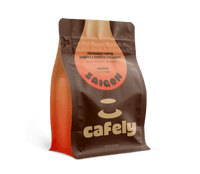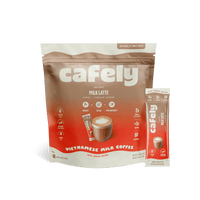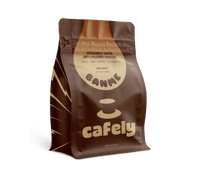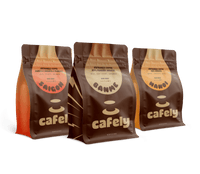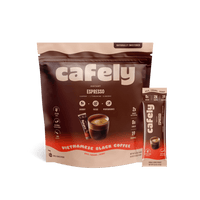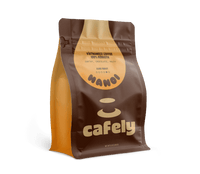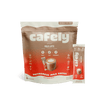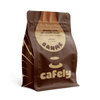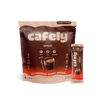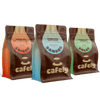There are more than 120 individual species in the genus Coffea. Despite the diversity, only two species are used for brewing coffee — arabica and robusta.
Both beans have their own set of pros and cons — arabica has a lighter, brighter, more complex taste; but is difficult to grow, produces very low yields, and contains only half the caffeine content compared to robusta.
Conversely, robusta is much stronger and easier to grow than arabica but lacks some depth in terms of its flavor profile.
Here are 5 key factors that make arabica and robusta coffee different:
- Appearance — Robusta beans are small, round, and pale in color. Arabica beans are large, oval, and darker in color.
- Growing conditions — Arabica beans must be grown at high altitudes and require maintenance, but robusta beans thrive at low altitudes with minimal care.
- Caffeine Content — Robusta beans contain almost twice as much caffeine as arabica beans.
- Cost — Robusta has a greater yield and is cheaper to produce than arabica.
- Flavor Profile — Robusta beans have an intense, slightly bitter taste compared to arabica’s sweeter, fruitier profile.
Summary: Key Differences Between Arabica & Robusta:

What is Arabica Coffee?
The origin of Arabica coffee comes from the Coffea arabica plant, which is native to Ethiopia and is identified by its large leaves and the fact that it can grow as tall as 6 meters.
Arabica makes up most of the world’s coffee bean production due to its smooth, fruity taste with hints of chocolate. It’s favored by many because it has a more delicate flavor than robusta.
Arabica beans can be difficult to grow because they need a particular environment. The plants need a subtropical climate and fertile soil with plenty of sun, shade, and moisture. They require high altitudes to survive and do not take kindly to temperature fluctuations. Arabica is highly susceptible to disease and pest attacks, produces about half the yield of robusta plants, and has a longer maturation period, meaning a longer wait for the beans. Arabica beans are normally hand-picked, which means more manual labor and higher costs.
Arabica beans tend to be darker in color than robusta, with a large ridge in the center, and they are usually bigger and oval in shape. One of the reasons for arabica’s sweeter flavor is its higher sugar, lipid, and acid content. It also contains much less caffeine.
What is Robusta Coffee?
Robusta coffee comes from the Coffea canephora plant and is grown in hot places such as Vietnam and Western Africa. These compact plants have small leaves and can grow to approximately 4.5 meters. Robusta has a rather intense profile with a slightly bitter taste.
Robusta plants thrive at low altitudes between sea level and 800 meters. They are very hardy and robust, as their name suggests. They have almost double the caffeine content of arabica beans, which makes them naturally resistant to pests and diseases. They also have a shorter maturation period of 6–8 months and can be harvested using mechanical equipment to speed up the production process.
Robusta beans have a less pronounced crease down the center of the bean, and they are smaller, rounder, and paler than arabica beans.
Which Coffee Bean is Best: Arabica or Robusta?
The answer depends on what qualities you want from your coffee and how you plan to brew it:
- Robusta — It’s better if you prefer a strong, bold, and highly caffeinated drink like Vietnamese coffee. It’s a great option for use while studying or working late when you need an extra energy boost or if you enjoy espresso and espresso-based drinks. Robusta coffee is also more sustainable and better, overall, for the planet.
- Arabica — This bean is better if you prefer a cup with more fruity, earthy, and smooth flavors. Many arabica coffees are almost “tea-like, with a bright flavor. Arabica is typically the better option for pour-over style coffeemakers.

The Importance of Choosing High-Quality Coffee
Regardless of what coffee you choose, getting high-quality beans is the most important. There are plenty of “bad” arabicas and “bad” robustas out there. Many factors can affect the overall taste of both beans, including weather, soil conditions, growing conditions, and brewing methods.
Improperly stored coffee can also lead to a bad flavor in the final brew — so always source your beans from companies selling fresh-roasted, high-quality beans grown without the use of harsh chemical pesticides.

Check out our lineup of authentic, high-quality coffee:
- SaiGon OG — Our signature blend features arabica, robusta, & peaberry roasted with butter for an extra-strong, classic flavor.
- HaNoi — Contains 100% pure Vietnamese robusta coffee.
- BanMe — The strongest coffee in the world, made with high-grade shade-grown peaberry robusta.
- DaLat — Contains 100% pure Vietnamese arabica coffee.
- DaNang — An equal mix of arabica & robusta coffee grown in the central highlands of Vietnam.
Most mass-produced instant coffees are made using the robusta bean — though great-tasting instant coffees are available, such as the Cafely Vietnamese Instant Coffee packs.
Because both have strengths, these beans are often sold as blends. Combining the two can produce coffee with a greater depth of flavor.
FAQs: Arabica vs. Robusta

Check out our FAQ section to answer more of your coffee queries.
1. Which coffee blend do you recommend?
The type of coffee you should use depends on the brewing method and style of coffee you’re preparing. For Vietnamese coffees, we highly recommend a full robusta or arabica-robusta blend — such as our Saigon OG Coffee (robusta x arabica x peaberry), which perfectly balances the flavor and effect profiles of both arabica and robusta coffee.
If brewing with an espresso machine, plunger-style brew method, moka pot, or AeroPress brewer, we recommend any dark roast coffees — such as our BanMe or HaNoi coffees.
However, if you're using pour-over coffees like the Hario V60 or Chemex brewer) we recommend a 100% arabica coffee instead (check out our DaLat coffee).
2. Why is robusta becoming so popular these days?
There’s no doubt robusta coffee is making a major comeback.
There are 3 main reasons for robusta’s recent rise in popularity:
- Climate Change — As temperatures increase and rainfall becomes less predictable, some coffee regions become too hot and dry for coffee plants to grow successfully. Robusta plants are less picky than arabica and will likely survive difficult weather conditions and environmental factors more easily, which could give rise to a greater demand for production.
- Flavor Profiles — Many people are turning towards robusta for it’s bold, rich, and explosive flavor profile over the subtle, fruitiness of arabica.
- Caffeine Content — People who want their coffee to hit hard and strong prefer to drink robusta, which contains twice as much caffeine as typical arabica.
3. What are the main differences in flavor between arabica & robusta coffee beans?
Arabica beans are known for their sweet and delicate flavor profile, featuring fruity notes with hints of chocolate, making them lighter and more complex. In contrast, robusta beans have a stronger, more intense taste that is often described as woody, nutty, and slightly bitter. The higher caffeine content in robusta also contributes to its stronger and somewhat harsher flavor.
4. How do the growing conditions differ between arabica & robusta coffee plants?
Arabica coffee requires high altitudes (600–2000 meters) and a cooler climate (15–25ºC), thriving under shade with high humidity. These conditions make it more challenging for arabica beans to thrive.
Robusta, however, grows well at lower altitudes (300–600 meters) and can tolerate hotter and more humid conditions (up to 26ºC), making it easier and cheaper to cultivate with higher yields. The difference between how coffee is made, cultivated, and processed affect its aroma and flavor profiles.
